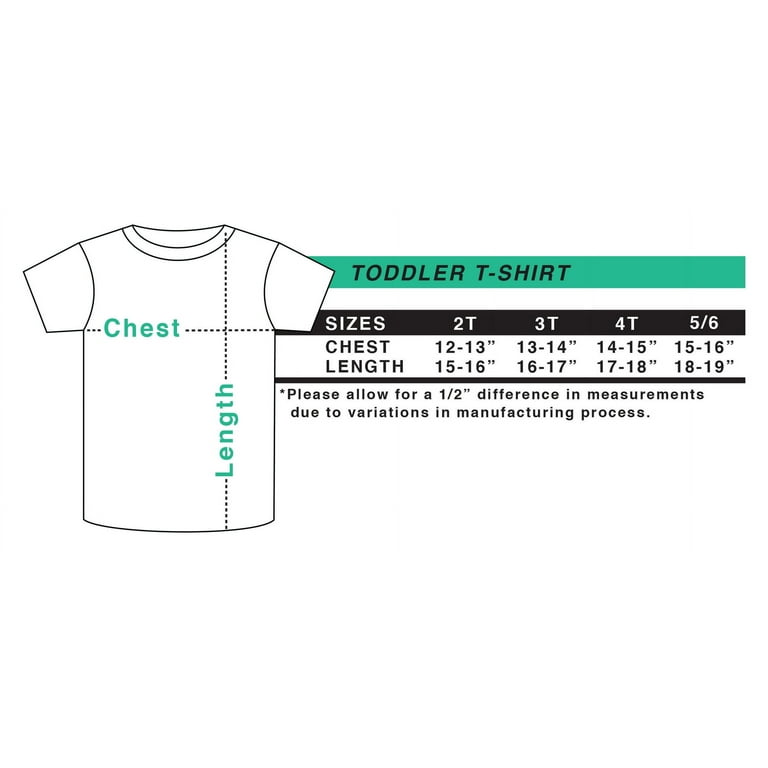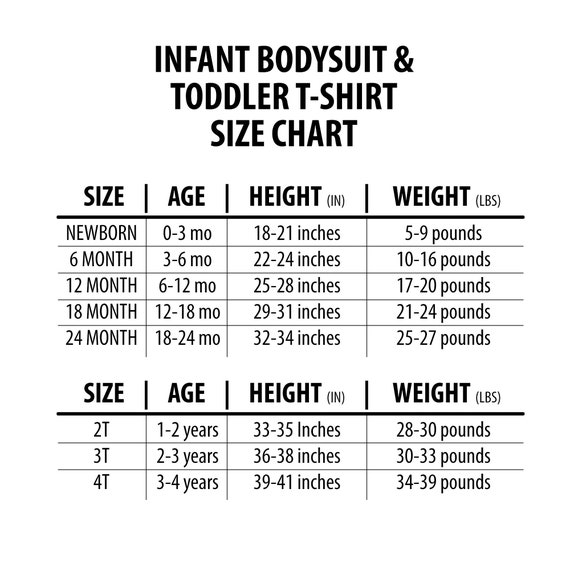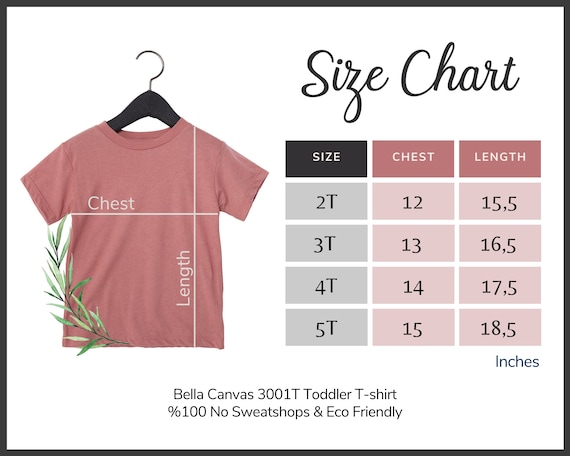The 2T size typically fits toddlers aged 2 to 3 years, with a height range of 33-36 inches and a weight of 26-30 pounds. Always check specific brand sizing charts, as they can vary.
Choosing the right size for your toddler can be challenging, especially with the wide range of clothing brands available. The 2T size is a popular choice for parents looking for comfortable and stylish options for their little ones. Understanding the measurements associated with this size ensures a good fit, allowing for both play and movement.
Proper sizing not only enhances comfort but also boosts confidence in young children. This guide simplifies the 2T size chart, making it easier for parents to make informed decisions when shopping for their toddlers.
Table of Contents
Decoding 2t: What It Really Means
Understanding the 2T size can be tricky for parents. This size is designed for toddlers. It represents a specific age and body type. Knowing these details helps in choosing the right fit for your child.
Age And Weight Guidelines
The 2T size typically fits toddlers aged 2 years old. Here are some general guidelines:
- Age: 2 years old
- Weight: 25 to 30 pounds
These guidelines can vary by brand. Always check the specific size chart for accuracy. A correct fit ensures comfort and ease of movement.
Height And Length Considerations
Height is another important factor for selecting 2T shirts. Most 2T shirts fit toddlers who are:
| Height Range | Average Length |
|---|---|
| 32 to 36 inches | 16 to 18 inches |
Choosing the right length helps avoid discomfort. Kids need freedom to play. A good fit allows them to explore freely.
Always consider your child’s growth. They may outgrow clothes quickly. Check size charts regularly for the best fit.

Credit: www.walmart.com
Comparison: 2t Vs. 24 Months
Choosing between 2T and 24 months can be tricky for parents. Both sizes cater to toddlers but vary in design and fit. Understanding the differences helps you select the right size for your child.
Design Differences
The design differences between 2T and 24 months are notable. Here’s a quick overview:
- 2T: Usually features a more relaxed fit. Often designed for toddlers who are active and growing.
- 24 Months: Tends to fit closer to the body. It is often styled for infants transitioning to toddler sizes.
Many brands have unique styles. Always check the label for specific design attributes. This ensures a good fit for your little one.
Sizing Nuances
Understanding the sizing nuances is crucial. Here’s how they compare:
| Size | Age Range | Chest Measurement | Length Measurement |
|---|---|---|---|
| 2T | 2 years | 21-22 inches | 15-16 inches |
| 24 Months | Up to 2 years | 20-21 inches | 14-15 inches |
Sizes can vary by brand. Always measure your child to ensure a proper fit. A good fit allows for freedom of movement.
Essential Measurements For 2t
Finding the right fit for your child is crucial. The 2T size is popular for toddlers aged 2 to 3 years. Accurate measurements ensure comfort and ease of movement. Focus on two main areas: chest and waist circumference, inseam, and sleeve length.
Chest And Waist Circumference
Measuring the chest and waist helps determine the best fit. Use a soft measuring tape for accuracy.
- Chest Circumference: Measure around the fullest part of the chest.
- Waist Circumference: Measure around the natural waistline.
Here’s a quick reference table:
| Measurement | Size (2T) |
|---|---|
| Chest | 20-22 inches |
| Waist | 19-20 inches |
Inseam And Sleeve Length
Inseam and sleeve length are also important. These measurements ensure the shirt fits well.
- Inseam: Measure from the crotch to the ankle.
- Sleeve Length: Measure from the shoulder to the wrist.
Check the following table for sizes:
| Measurement | Size (2T) |
|---|---|
| Inseam | 12-14 inches |
| Sleeve Length | 12-13 inches |
Use these measurements to find the perfect 2T shirt. Happy shopping!
International Sizing Variations
Understanding international sizing can be tricky for parents. Different countries use different systems. This can lead to confusion when choosing a 2T T-shirt for your child. Knowing the differences helps in finding the right fit.
Us Vs. European Sizes
The United States and Europe have different size charts. Here’s a quick comparison:
| US Size | European Size |
|---|---|
| 2T | 86 |
| 3T | 92 |
In the US, sizes are simpler. They use numbers like 2T. European sizes are based on centimeters. For example, 86 cm usually fits a 2T size.
Understanding Asian Sizes
Asian sizes can be quite different. They often run smaller than US sizes. Here’s a quick guide:
- 2T in Asia may equal a size 90.
- Always check the size chart before buying.
- Fit can vary by brand.
Check measurements in centimeters. This helps in making better choices.
Seasonal Considerations In Sizing
Choosing the right size for your child’s 2T shirt goes beyond just numbers. Seasonal changes affect how clothing fits and feels. Parents must consider the fabric and the layering needs for both summer and winter. Here’s how to navigate these seasonal sizing challenges.
Summer Vs. Winter Wardrobe
Summer and winter wardrobes require different sizing strategies. In summer, kids wear lighter fabrics. In winter, they need thicker materials for warmth.
- Summer: Opt for loose-fitting shirts.
- Winter: Choose slightly larger sizes for layering.
| Season | Size Consideration | Fabric Type |
|---|---|---|
| Summer | True to Size | Cotton, Linen |
| Winter | One Size Up | Wool, Fleece |
Layering And Fit
Layering changes how a shirt should fit. A snug fit works for summer tops. For winter, a looser fit is better.
- Choose a base layer for winter.
- Add a thicker shirt or sweater.
- Finish with a jacket or coat.
For summer, a simple t-shirt is perfect. It allows for comfort and breathability. Always ensure the fabric is soft against the skin.
The Role Of Brands In 2t Sizing
Understanding 2T sizing is crucial for parents. Different brands offer varying sizes. This can lead to confusion during shopping. Recognizing these differences helps you choose the right fit.
Recognizing Brand Sizing Discrepancies
Each brand has its own sizing chart. This can create inconsistencies. Here are some common discrepancies to watch out for:
- Some brands run larger than others.
- Others may fit smaller than expected.
- Age recommendations may vary greatly.
Always compare size charts before buying. Pay attention to customer reviews. They often highlight sizing issues. Use this information to make informed choices.
Trusted Brands For True-to-size Fits
Not all brands are created equal. Some consistently provide accurate sizing. Here are a few trusted brands:
| Brand Name | Size Accuracy |
|---|---|
| Carters | True to Size |
| Old Navy | True to Size |
| Burt’s Bees Baby | True to Size |
Choosing these brands can simplify your shopping experience. They provide reliable fits for growing toddlers.
Fabric Types And Size Flexibility
Choosing the right fabric type is essential for your child’s comfort. Toddlers grow quickly. Their clothes need to adapt. Understanding fabric types helps ensure a good fit. Here’s a closer look at the options.
Stretchable Fabrics For Growing Toddlers
Stretchable fabrics offer great flexibility. They allow for movement and comfort.
- Spandex: Adds stretch, perfect for active toddlers.
- Cotton blends: Soft and breathable, often mixed with spandex.
- Modal: Smooth and stretchy, great for sensitive skin.
These fabrics can accommodate growth. They fit snugly without being tight.
Non-stretch Materials And Sizing
Non-stretch fabrics provide a different experience. They may not fit as snugly. Here are some common types:
| Fabric Type | Characteristics | Best For |
|---|---|---|
| Cotton | Soft, breathable, and durable | Everyday wear |
| Polyester | Strong and quick-drying | Active play |
| Canvas | Heavy-duty and sturdy | Outerwear and durable use |
Non-stretch fabrics require careful sizing. Parents should measure their child accurately.
Size guides can help with this. Always check the size chart before buying.
Adjustable Features For Growth Spurts
Children grow quickly. Parents need clothes that can keep up. Adjustable features in 2T T-shirts help ensure a perfect fit. These features allow shirts to grow with your child. They offer comfort and longevity, saving money in the long run.
Elastic Waistbands And Adjustable Straps
Elastic waistbands are a game-changer. They provide flexibility for growing bodies. This feature ensures a snug fit without discomfort.
- Stretchy material adapts to movement.
- Reduces the need for constant adjustments.
- Offers extra room for growth spurts.
Adjustable straps are also useful. They allow for easy size adjustments. Parents can customize the fit as needed.
Extendable Hems And Cuffs
Extendable hems and cuffs are great for longevity. They can stretch to accommodate growth. This feature keeps shirts fitting well for longer periods.
- Hems can be let down as children grow.
- Cuffs can be rolled up or extended.
- Maximizes wearability of each shirt.
These adjustable features make 2T T-shirts a smart choice. They provide comfort and adaptability. Investing in these shirts pays off as your child grows.
Navigating Online Size Charts
Finding the right size for your child can be tricky. Online size charts help parents make informed choices. Understanding these charts can save time and ensure a great fit.
How To Read And Interpret Size Charts
Reading a size chart is simple. Follow these easy steps:
- Locate the Size: Find the size you need, like 2T.
- Check the Measurements: Look for height and weight ranges.
- Understand the Fit: Some brands fit differently.
| Size | Height (inches) | Weight (lbs) |
|---|---|---|
| 2T | 33 – 36 | 28 – 30 |
Tips For Online Shopping
Online shopping for kids’ clothes can be fun. Follow these tips for a smoother experience:
- Measure Your Child: Use a tape measure for accurate sizes.
- Read Reviews: Check what other parents say about sizing.
- Check Return Policies: Ensure easy returns for wrong sizes.
- Compare Brands: Sizes may vary across different brands.
Using these strategies makes shopping easier. Happy shopping!
Creating A Personalized Size Chart
Parents can create a personalized size chart for their kids. This helps find the right fit for T-shirts. Understanding your child’s measurements ensures comfort and style. Follow the steps below to make a custom size chart.
Diy Measurement Techniques
Measuring your child is simple. You will need a flexible measuring tape and some basic tips.
- Chest Width: Measure around the fullest part of the chest.
- Length: Measure from the highest point of the shoulder to the desired length.
- Shoulder Width: Measure from one shoulder to the other.
- Sleeve Length: Measure from the shoulder seam to the wrist.
Take these measurements with your child standing straight. Write down the numbers for reference.
Charting Your Child’s Growth
Children grow quickly. Regularly updating the size chart is essential. Here’s how to keep track:
- Measure your child every 3-6 months.
- Record the new measurements in a table.
- Compare the growth with previous measurements.
Consider creating a simple table:
| Measurement | Month 1 | Month 3 | Month 6 |
|---|---|---|---|
| Chest Width | 22 inches | 24 inches | 26 inches |
| Length | 15 inches | 16.5 inches | 18 inches |
| Shoulder Width | 11 inches | 12 inches | 13 inches |
| Sleeve Length | 12 inches | 13.5 inches | 15 inches |
Refer to this chart before buying new T-shirts. This helps ensure a perfect fit every time.
Common Misconceptions About 2t Sizing
Parents often face confusion about 2T sizing. Many believe it is a straightforward measurement. Misunderstandings can lead to poor fitting clothes. Let’s clear up some of these myths.
Myth Vs. Reality
Here are some common myths regarding 2T sizing:
- Myth 1: 2T means the child is 2 years old.
- Reality: 2T is a size, not an age. It fits toddlers aged 2-3.
- Myth 2: All brands size 2T the same.
- Reality: Sizing varies by brand. Always check specific size charts.
- Myth 3: 2T is the same as a size 2.
- Reality: Size 2 is smaller than 2T. 2T offers extra room for diapers.
Avoiding Sizing Pitfalls
To ensure the best fit, follow these tips:
- Measure your child: Use a measuring tape to check height and weight.
- Check the size chart: Always refer to the brand’s size chart.
- Consider growth: Buy a size up if your child is close to 3 years old.
- Try it on: If possible, have your child try the shirt before buying.
Understanding these points helps parents make better choices. Avoiding misconceptions ensures a happy dressing experience for both kids and parents.

Credit: www.etsy.com
The Impact Of Laundry On 2t Clothes
Parents often face challenges with maintaining 2T clothes. Laundry impacts size and fit significantly. Understanding how to care for these garments ensures longer wear. Proper laundry techniques prevent shrinkage and preserve the shape.
Shrinkage Factors
Several factors cause shrinkage in 2T clothes:
- Heat: High temperatures in dryers lead to shrinkage.
- Water Temperature: Hot water can shrink fabrics.
- Fabric Type: Cotton shrinks more than synthetic blends.
Always check labels for specific care recommendations. Avoid high heat to keep clothes fitting well.
Care Instructions For Size Preservation
Follow these care instructions to maintain size:
- Wash in cold water.
- Use gentle cycle settings.
- Avoid dryer use; air dry instead.
- Turn garments inside out before washing.
By following these steps, you can reduce shrinkage. This helps keep 2T clothes fitting your child for longer.
| Shrinkage Factor | Recommended Action |
|---|---|
| Heat | Use low heat settings |
| Water Temperature | Wash in cold water |
| Fabric Type | Choose blends over pure cotton |
Expert Tips For Dressing Your 2t Toddler
Dressing your 2T toddler can be fun and challenging. Knowing the right tips helps you choose the best outfits. Comfort and mobility are key for active little ones. Keep these factors in mind for happy, stylish toddlers.
Comfort And Mobility
Comfort is essential for your toddler’s daily activities. Look for clothes made from soft, breathable fabrics. Cotton is a great choice because it is gentle on the skin. Here are some tips to ensure comfort:
- Choose stretchy materials for easy movement.
- Check for tags that may irritate the skin.
- Avoid tight-fitting clothes that restrict movement.
- Opt for adjustable waistbands for better fit.
Mobility is just as important. Your toddler loves to run and play. Clothes should allow for bending, jumping, and climbing. Pick outfits that help them stay active and comfortable.
Transitioning Between Sizes
As your toddler grows, they will need different sizes. Transitioning from 2T to 3T can be tricky. Here are some tips to make this change easier:
- Measure your toddler regularly to track their growth.
- Check size charts before buying new clothes.
- Consider layering for colder weather.
- Buy clothes with a little extra room to grow.
Choose brands that offer adjustable features. This way, clothes can last longer. Always prioritize comfort and fit for your growing child.
| Size | Height (inches) | Weight (lbs) |
|---|---|---|
| 2T | 33 – 36 | 25 – 30 |
| 3T | 36 – 39 | 30 – 34 |
Understanding sizes helps you pick the right clothes. Happy dressing leads to happy toddlers!

Credit: www.etsy.com
Frequently Asked Questions
What Is A 2t Shirt Size?
A 2T shirt size typically fits toddlers aged 2-3 years, offering a relaxed fit for comfort and mobility.
How Do I Measure My Child For 2t?
Measure your child’s chest and height. Compare these measurements with a size chart for accurate fitting.
Are 2t Sizes The Same As 2 Years?
Not always. 2T sizes account for extra room and movement, while “2 years” may refer to actual age.
What Brands Offer 2t Sizing?
Popular brands like Carter’s, OshKosh, and Gap provide 2T options, ensuring a variety of styles and fits.
Conclusion
Choosing the right 2T shirt size for your child ensures comfort and confidence. Understanding the size chart simplifies shopping for parents. Always measure your child before making a purchase. This way, you can avoid unnecessary returns and disappointment. Happy shopping, and may your little ones wear their new tees with joy!







